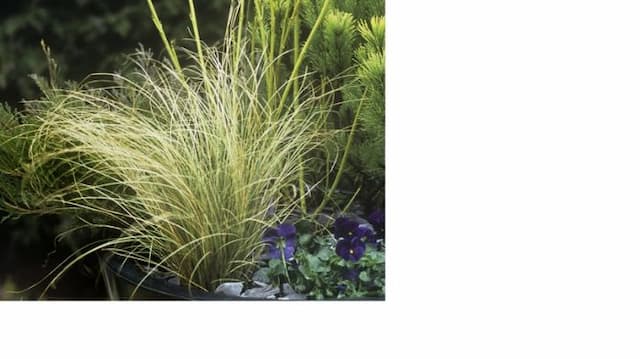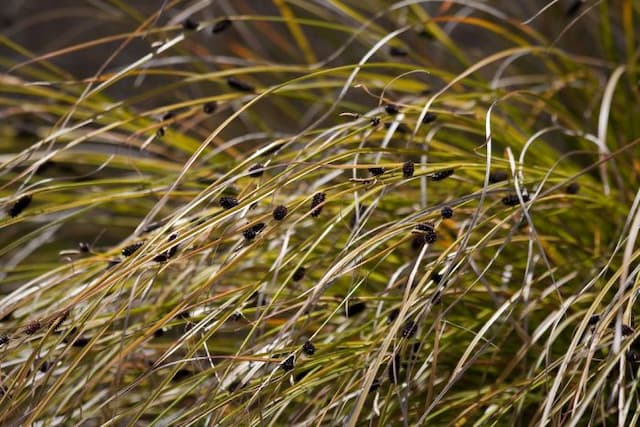Red Hook Sedge Uncinia rubra 'Belinda's Find' (PBR)

ABOUT
Uncinia rubra 'Belinda's Find' is a striking ornamental grass known for its vibrant foliage and captivating visual appeal. Its leaves boast a rich, fiery red hue, creating a warm and colorful display that stands out among garden greenery. The narrow, arching blades of grass add a sense of movement and texture to the landscape, with their edges often highlighted by a subtle, contrasting color that enhances their overall look. This plant produces small, inconspicuous flower spikes that may add to its texture but are not the main feature; the focus remains firmly on the stunning red foliage that can appear almost metallic or glossy in certain lights. Vibrant and elegant, 'Belinda's Find' adds rich, year-round color to gardens, making it a favored choice for those looking to infuse their outdoor spaces with an enduring and dramatic visual statement.
About this plant
 Names
NamesFamily
Cyperaceae
Synonyms
Red Hook Sedge, Belinda's Red Hook Sedge
Common names
Uncinia rubra 'Belinda's Find' (PBR).
 Toxicity
ToxicityTo humans
The Uncinia rubra, commonly known as Hook Sedge, is not known to be toxic to humans. There are no widespread reports of poisoning or adverse symptoms associated with ingestion or handling of this plant. Therefore, the toxicity to humans, if any, is likely to be minimal.
To pets
Hook Sedge is not commonly reported as a toxic plant for pets. There is limited information available on the toxicity of Uncinia rubra ‘Belinda’s Find’ to pets, but it is not listed among the commonly recognized poisonous plants for animals such as dogs and cats. The lack of reports suggests that it is unlikely to cause significant poisoning or severe symptoms if pets ingest parts of the plant. However, as with any non-food plant, ingestion can sometimes lead to mild gastrointestinal upset.
 Characteristics
CharacteristicsLife cycle
Perennials
Foliage type
Evergreen
Color of leaves
Red
Height
1-2 feet (30-60 cm)
Spread
1 foot (30 cm)
Plant type
Grass
Hardiness zones
8
Native area
New Zealand
Benefits
 General Benefits
General Benefits- Ornamental Appeal: Uncinia rubra 'Belinda's Find' provides striking visual interest with its rich, reddish-bronze foliage that adds color and texture to garden spaces.
- Low Maintenance: It requires minimal upkeep once established, making it ideal for gardeners who prefer plants that do not need a lot of attention.
- Drought Tolerance: Once established, the plant can tolerate periods of dryness, reducing the need for frequent watering.
- Cold Hardiness: It is capable of withstanding cooler temperatures, making it suitable for a variety of climates.
- Compact Size: Its modest size allows it to fit well in small gardens or as part of mixed containers without overwhelming the space.
- Year-Round Interest: The foliage retains its color throughout the seasons, ensuring that the garden has enduring appeal across the year.
- Erosion Control: Its root system can help to stabilize soil on slopes or in areas prone to erosion.
- Attracts Wildlife: While it does not specifically attract any particular wildlife, its dense growth can provide shelter for small creatures.
- Easy Propagation: It can be easily propagated by division, allowing gardeners to create more plants for other areas of their garden or to share with friends.
- Versatile Usage: Suitable for planting in borders, rock gardens, or as ground cover, offering versatility in garden design and planting schemes.
 Medical Properties
Medical PropertiesThis plant is not used for medical purposes.
 Air-purifying Qualities
Air-purifying QualitiesThis plant is not specifically known for air purifying qualities.
 Other Uses
Other Uses- Artistic Inspirations: The striking red hues of Uncinia rubra can be used as a reference for artists looking to replicate similar colors in their work, providing a vibrant natural palette.
- Photography Subject: Due to its distinctive color, it serves as an excellent subject for macro and garden photographers trying to capture the beauty of unique garden species.
- Educational Tool: Botany teachers may use Uncinia rubra as a specimen to explain plant adaptation, particularly how some plants evolve to attract pollinators or interact with their environment.
- Color Dye Source: The red blades could potentially be used to create a natural dye for fabrics, though this use might require extensive research and experimentation.
- Landscape Design: Used as an example in landscape architecture courses and workshops, to show how color and texture can be integrated into garden design.
- Theme Gardens: It can be included in 'fire' or 'hot' themed gardens to represent the element with its fiery red coloring.
- Craft Materials: Dried leaves of the Uncinia rubra can be utilized in craft projects, such as in wreath making or as part of decorative floral arrangements.
- Erosion Control: While not commonly used for this purpose, its ability to form dense clumps can make it suitable for stabilizing soil in garden slopes and preventing erosion.
- Cultural Significance: The plant can be integrated into cultural studies or garden designs that focus on New Zealand native plants, as it originates from this region.
- Horticultural Studies: It can be used in studies focused on understanding the growth patterns and environmental tolerances of ornamental grasses.
Interesting Facts
 Feng Shui
Feng ShuiThe Uncinia rubra is not used in Feng Shui practice.
 Zodiac Sign Compitability
Zodiac Sign CompitabilityThe Uncinia rubra is not used in astrology practice.
 Plant Symbolism
Plant Symbolism- Passion: The rich red color of Uncinia rubra 'Belinda's Find', commonly known as Red Hook Sedge, often symbolizes strong emotions and passion.
- Vitality: The vibrancy of its foliage can represent life, vigor, and energy.
- Uniqueness: As a distinctive ornamental grass, Red Hook Sedge may symbolize the value of being unique or standing out in a crowd.
 Water
WaterThe Red Hook Sedge prefers consistent moisture and should be water regularly, especially during dry spells. Water the plant deeply once a week, providing enough water so that it reaches the roots, roughly equivalent to 1 gallon per watering for an established plant. During hotter months or in particularly dry climates, it may require watering twice a week. In contrast, reduce the frequency of watering during cooler months to prevent waterlogging. Always check the top inch of soil for dryness before watering to ensure the plant does not get overwatered.
 Light
LightThe Red Hook Sedge thrives best in full sun to partial shade. It should be placed in a location where it can receive at least four hours of direct sunlight daily. Although it can tolerate some shade, too little light can lead to less vibrant foliage colors. An ideal spot would be one that offers morning sun and afternoon shade, especially in regions with very hot summers.
 Temperature
TemperatureThe Red Hook Sedge is hardy and can withstand temperatures as low as 20 degrees Fahrenheit, but it grows best in temperatures ranging from 60 to 75 degrees Fahrenheit. This plant should be protected from extreme cold and frost, as temperatures below 20 degrees can damage it. During the summer, the Red Hook Sedge can tolerate higher temperatures, but it will need additional watering to cope with the heat.
 Pruning
PruningPruning the Red Hook Sedge is important to maintain its shape and encourage new growth. This should be done in early spring before new growth starts. Remove any dead or damaged leaves at the base to promote air circulation. Additionally, cutting back the foliage by one-third every couple of years can rejuvenate the plant and keep it looking full and healthy. Pruning is usually done annually or biennially, depending on the plant's condition and appearance.
 Cleaning
CleaningAs needed
 Soil
SoilRed hook sedge thrives best in consistently moist, well-draining soil with a slightly acidic to neutral pH between 6.0 and 7.0. A mix of peat, loamy soil, and sand is ideal to ensure proper drainage and moisture retention.
 Repotting
RepottingRed hook sedge generally does not require frequent repotting and can be done every 2-3 years or when the plant outgrows its current container, to refresh the soil and provide more room for growth.
 Humidity & Misting
Humidity & MistingRed hook sedge prefers high humidity conditions, generally around 50% to 70%, to thrive and maintain its vibrant foliage color.
 Suitable locations
Suitable locationsIndoor
Place in bright indirect light, keep soil moist.
Outdoor
Provide moist soil, partial shade; shelter from harsh sun.
Hardiness zone
8-9 USDA
 Life cycle
Life cycleUncinia rubra 'Belinda's Find', commonly known as Red Hook Sedge, begins its life as a seed, typically germinating in moist, well-drained soil conditions during spring. The seedlings emerge and develop into juvenile plants, which grow by producing distinctive, reddish-bronze foliage. As the plants mature, they form dense clumps and the foliage becomes more pronounced in color, especially when exposed to full sunlight. During summer, small, inconspicuous brown flower spikes may appear, completing its reproduction stage. After flowering, seeds are produced and dispersed, potentially giving rise to new plants. The plant is a perennial, which means it will return each year from its root system, going through a period of dormancy during the colder winter months before resuming growth in the spring.
 Propogation
PropogationPropogation time
Spring-Early Summer
The most popular method of propagation for the plant Uncinia rubra 'Belinda's Find', commonly known as the Red Hook Sedge, is by division. This process is typically done in late winter or early spring, just before new growth begins. To propagate by division, carefully lift the mature plant from the soil, using a spade or fork to minimize root damage. You then gently tease apart the clumps into smaller sections, each with its own set of roots, making sure that each division has at least a few growing points or shoots. These divisions can then be replanted into moist, well-draining soil, spaced around 8 to 12 inches apart (roughly 20 to 30 centimeters), and watered in well to establish the new plants.









